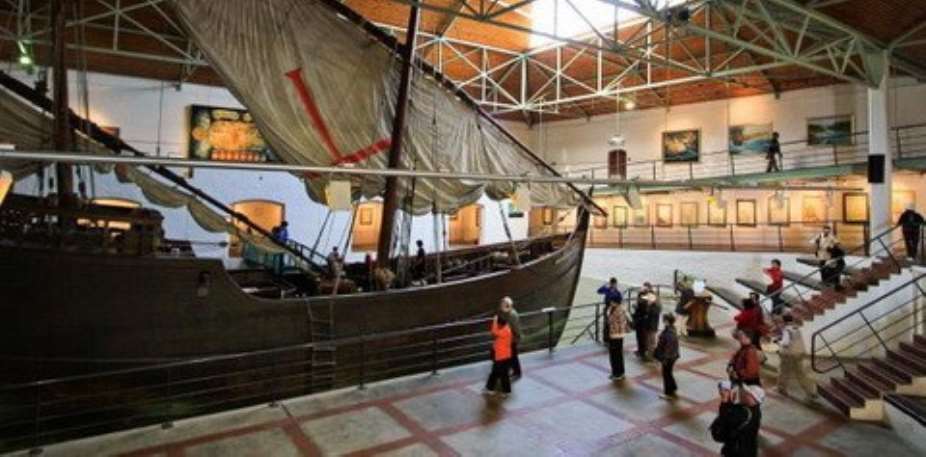The Maritime Museum in Mossel Bay is packed with maps, displays and dioramas depicting the age of sail and exploration along the Western Cape coastline. The centrepiece of the museum is the Bartolomeu Dias, a life-size replica of 1 of the feisty caravels used by the Portuguese discoverers of old.
Standing on the wooden poop deck of the Bartolomeu Dias in the Maritime Museum in Mossel Bay is about close as most of us will ever get to experiencing the old days of sail.
The Bartolomeu Dias is an almost-exact, if slightly modernised, replica of the Portuguese caravel, a diminutive trading ship mainly used in the Mediterranean or for long-range sailing in the 15th and 16th centuries.
It is this kind of vessel that bore famous Portuguese explorer and navigator Bartolomeu Dias and his crew around the dangerous Cape of Good Hope (also known as the Cape of Storms) and on to Mossel Bay on the east coast of South Africa in February 1488.
Walk around the little ship and let your mind's eye build a scenario of wind and wave, cutlass and adventure, the open seas and the 1st sightings of Africa. The crew used to cook meats and fish on an open fire on a stone slab on the deck. They would eat that with stored biscuits and wash it down with water or, on special occasions, wine.
This large boat – or mini-ship – you're on has quite an illustrious history for a replica vessel.
The man who had the dream of building an old caravel in modern times was Captain Emilio de Sousa, a South African of Portuguese descent. He led the crew of 17 South African and Portuguese sailors who began 'learning the ropes' of ancient seafaring once the ship was built in November 1987.
They set sail from Lisbon, Portugal, in December that year, and just more than 2 months later they arrived at Mossel Bay. De Sousa and his men had had an incredible journey southwards, spending Christmas on the high seas and celebrating with cake, turkey and that Portuguese dried fish staple, bacalhau.
The back-story of the Bartolomeu Dias is heart-warming. More than R1-million was raised through the fundraising efforts of the South African Portuguese community.
In July 1986, work on the caravel began in a port called Vila do Condo, north of Lisbon. The designers walked a tight line between historical authenticity and modern convenience, building in up-to-date features like electronic navigation equipment, flush toilets and stoves.
In the golden era of wind-driven ships, the sails were mostly made of sisal. The replica caravel's sails were made of nylon and Dacron.
The next big question was where to ensconce the Bartolomeu Dias once it arrived in Mossel Bay. It was decided to use an old grain and saw mill standing near the shore.
The building – now part of the Dias Museum Complex – was duly enlarged, with a sizeable gap left open at the back so that the star of the new Maritime Museum could be accommodated. The caravel was partially dismantled, towed over greased wood, and then moved inside the building to her resting place with the help of a hydraulic system.
Over the years, the deck of the Bartolomeu Dias has felt the footsteps of many naval fantasists – of all ages...





 Meta releases new version of conversational AI across its platforms
Meta releases new version of conversational AI across its platforms
 Cape Town named Africa’s Best Airport 2024 by Skytrax
Cape Town named Africa’s Best Airport 2024 by Skytrax
 Bono East: Four injured after hearse transporting corpse crashes into a truck
Bono East: Four injured after hearse transporting corpse crashes into a truck
 ‘Be courageous, find your voice to defend our democracy’ — Sam Jonah urges journ...
‘Be courageous, find your voice to defend our democracy’ — Sam Jonah urges journ...
 Exodus of doctors, nurses and teachers have worsened because of unserious Akufo-...
Exodus of doctors, nurses and teachers have worsened because of unserious Akufo-...
 2024 election: Avoid insults, cutting down people in search of power – National ...
2024 election: Avoid insults, cutting down people in search of power – National ...
 ‘You passed through the back door but congratulations’ — Atubiga on Prof Jane Na...
‘You passed through the back door but congratulations’ — Atubiga on Prof Jane Na...
 Government’s $21.1 billion added to the stock of public debt has been spent judi...
Government’s $21.1 billion added to the stock of public debt has been spent judi...
 Akufo-Addo will soon relocate Mahama’s Ridge Hospital to Kumasi for recommission...
Akufo-Addo will soon relocate Mahama’s Ridge Hospital to Kumasi for recommission...
 We must not compromise on our defence of national interest; this is the time to ...
We must not compromise on our defence of national interest; this is the time to ...
